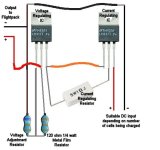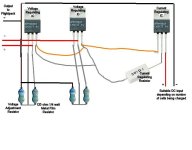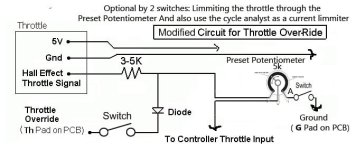The Mighty Volt said:
I am planning on fitting 100 A123 into an augmented space within the frame of my MTB, the triangular piece where the cross bar, diagonal and upright meet.
Assuming you mean the front triangle's toptube, downtube, and seattube (the "bike shop" names for the three main tubes of the front triangle), the first thing to determine is if indeed 100 of them *can* fit there.
Each one is 28mm diameter, give or take a bit. Assuming staggered rows for least space wastage, and that they'll be in a "single file" pattern so there is only one "layer" of them, with the ends of the cells pointed left and right of the bike, perpendicular to the bike's length. Then there is the thickness of whatever you use to space them apart a bit so they can't rub on each other and short out. Then the thickness of whatever you use to encase them so they don't rub on the bike frame itself.
FWIW, the overall idea is a common one for triangle-mounted packs of cylindrical cells. It is one possible plan I am considering for my LiPo/LiCo cells, once I get a BMS for them to safely use them without risk of destruction.

I dont know whether to go for a "perfect fit" triangle or whether to make up 8 cell packs with balance tabs and charge them with a Turnigy Accucell. Even if I knew that, I still would not be sure of how to connect the packs to come out with the 72v 11 Ah which 100 A123 M1 cells should provide.
Assuming they all fit, then for 3.3V per cell to get 72V you have to put 22 cells in series (72.6V, actually, nominal, though they could be as high as 3.6V+ per cell bringing the pack hot-off-the-charger voltage to at least 79.2V).
Assuming 2.3Ah per cell, then for 11Ah you'd need 5 strings of 22 cells in parallel, which actually comes out to 11.5Ah.
That's a total of 110 cells you'll actually need to fit in that triangle, plus insulation/casing/etc.
As for how to build it pack-wise, it depends on how you intend to charge it. If you are going to use an 8s charger, you're only going to be able to charge a bit more than two thirds of the pack that way, as it will be two 8s sections and one 6s section. So you also need a 6s charger, unless the 8s is a smart charger that can deal with 6s as well.
What I sort of planned to do with my LiPo/LiCo cells was build them into ~12V sections, as if they were SLAs. So they'll actually be about 14.8V sections, wired up in 4S blocks. Conveniently, the Fechter/Goodrum v2.6 BMS was in 4S sections, so each little board could go with a "mini pack", with interconnects to all the others in series, *or* to a separate control board (which I'd have to cut off of it's own little 4S board, since it's not normally separate). That way I don't have a whole bunch of little balancing cables running off to a main BMS board--I just have the series interconnect wires, which should be fewer in number.
I could then use these "12V blocks" to build whatever pack I needed for that testing or operating configuration, since it seems most common to use 12V increments for controller voltages. If I wanted I could parallel several sets series'd together, and then just series *all* of the sets together to charge them, without worrying about disconnecting/connecting the balance wires.
The actual wiring of your pack could be 5 separate series strings of 22 cells, or it could be 22 stacked parallel-wired sets of 5. I think the latter approach is the more recommended one from what I have read around the web, but it has it's disadvantages, too (if one cell dies totally shorted it'll take out everything directly paralled with it--not a likely scenario but a possible one).
I will probably need pictures to better inform people, so I will take care of that tomorrow.
[/quote]
You'll also need to get dimensions of the inside of the triangle, so that you can verify they'll fit.
One way to do this is to take a photo of the side view of the triangle from as far away as you can get with your camera and still use it's optical zoom function to fill the screen as fully as possible with the triangle. That way you can use that as a reference in the computer to begin drawing circles in it to determine if it will all fit.
Alternately, just lay the bike frame on it's side (this is easiest if it has no cranks or handlebars or seat on it, but usually just taking off the pedal from one side and taking the front wheel out will let it lay flat enough to do this). Then start placing actual cells in there, sitting on their ends on the floor, to see if they will indeed all fit in that space and leave you room for casing around them and such.






